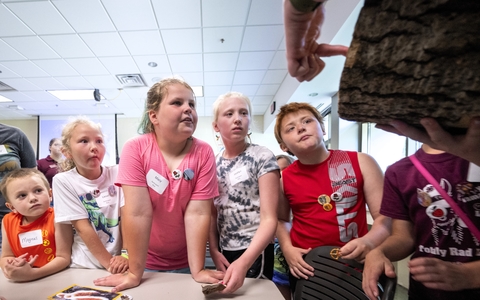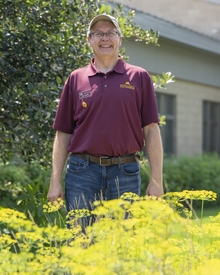Crop scouts in the 4-H plant science program get competitive, with world-class mentors to make the learning stick
Under a tent in a University of Minnesota crop research field on a hot July day, 14-year-old Molly Albers of Rice County inspected a soybean plant. With her team, she formed an observation based on what she had already learned as an advanced member of the 4-H plant science program.
“You’re getting there,” Seth Naeve responded, and then he asked Molly a follow-up question.
Naeve, a University of Minnesota Extension soybean specialist and one of the most knowledgeable people in the U.S. on the topic, encouraged Molly’s small group to think critically during the Extension 4-H crop scouting competition.
The advanced level is rigorous. Answers aren’t meant to come easily. But at the end of the day, Molly’s Rice County team took the prize.
“I discovered that I really like to learn about science, and the technology is really cool, too,” says Molly about her experience. “I even learned about some possible careers in the field of agriculture.”
Starting young
Crop scouting is a way to inspect crops for potential outcomes and risks. Scouts are people who make systematic observations and predictions while considering factors such as weather, products like pesticides and herbicides, and risks such as disease and pests.
“Since the 4-H plant science program began, it’s evolved to include the crop scouting competition, a knowledge bowl and more,” says Brian McNeill, Extension youth development educator.
It has also grown to include three age groups, starting in third grade and going through one year past high school.
Molly’s younger brother, Isaac, and sister, Macy, participate in the intermediate and junior divisions.
“I just really liked learning about the crops and stuff because it was my first year,” says Macy.
As always, 4-H is about the whole child, not only the scientific learning.
“The thing I enjoyed most was meeting new people,” says Isaac.
The future of agriculture
The competition equips the next generation with basic crop scouting and pest management skills helpful for any career in agriculture, environmental sciences or food production. It’s the culminating event where youth use what they’ve been learning through plant science activities in their local counties.
“We’re planting a seed, both figuratively and metaphorically,” says Dave Nicolai, an Extension crops educator who helps plan the contest, recruit judges and teach. “My favorite part is when you can light a little bit of a fire in the youth, build enthusiasm and get them to ask questions and be inquisitive.”
Youth participants work together and rely on each other as they solve problems.
“The part I like the most is watching them work together as a team,” says Dave Albers, a 4-H volunteer and father of Molly, Macy and Isaac. “The crop scouting and project bowl programs are hidden gems.”
Holding the competition at the University’s St. Paul campus crop research fields and laboratories also allows youth to experience a college campus and possibly become inspired to consider pursuing a college education in plant sciences.
“I loved being able to take seventh and eighth graders to St. Paul and show them that farm activities are happening on this renowned campus,” says Rita Scholten, 4-H volunteer and parent. “It’s super to have them see people studying and learning really important science.”
Youth also have the opportunity to work with a mentor when preparing for the competition, such as a farmer or an agronomist with one of the businesses that help support 4-H.
“Kids are involved in something they are interested in, and 4-H has experts standing there waiting to answer their questions,” adds Scholten. “They engage them in further conversation about what they’re thinking about, what they’re pondering.”
Allison Deplazes
An ambassador for agriculture
From plants to livestock, Minnesota 4-H Agriculture Ambassadors serve as positive representatives for both agriculture and 4-H. In 2024, 24 youth from around the state were selected to participate.
Allison Deplazes is one of them. During her 12 years in 4-H, she has participated in a wide variety of project areas: agriculture, rabbits, needle arts and more.
“Teaching is one of my favorite parts of the program,” says Allison. “I got to teach a lesson on agriculture to a group of fourth graders in my community.”
She has also attended national events, like Ignite by 4-H, which is held annually in Washington, D.C.
“I met people from around the country and talked about different practices and crops in other parts of the country that we might not have here in Minnesota,” she recalled.
Allison’s experience has solidified her decision to pursue a future career in agriculture.
“Right now, my plan is to specialize in agricultural communications,” she says. “And I completely attribute that to this program for giving me opportunities to be a bridge from producer to consumer. Filling that gap is definitely what I want to do.”






